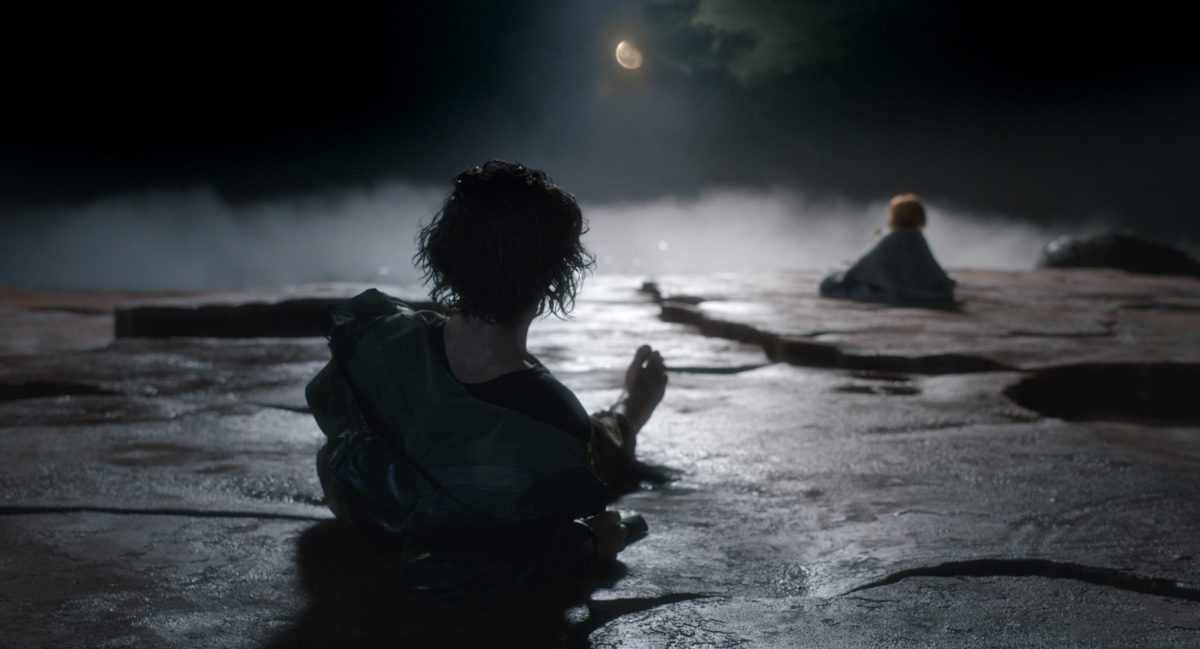
Annette became the most hyped arthouse film of the year on the strength of word of mouth around its sundry outré qualities, such as Adam Driver singing while going down on Marion Cotillard. If anything, that reputation turned out to be understated, since the movie musical’s theatrical release broke out several zanier qualities that had been kept under wraps, such as how the title character is a toddler portrayed by a wooden marionette. Such ideas are regular fare for French director Leos Carax, who collaborated on this script with Ron and Russell Mael of the venerable alt-pop duo Sparks, who also composed the film’s songs. But the true accomplishment of Annette is not that it drew together these idiosyncrasies, but that by the end they amount to something incredibly moving.
The film begins with Carax, the Maels, Driver, Cotillard, and other cast and crew and musicians “warming up” in a studio, out of character. A cheeky pre-show announcement sets the vibe: “We now ask for your complete attention. If you want to sing, laugh, clap, cry, yawn, boo, or fart, please do it in your head, only in your head.” Or maybe they are perfectly in character, with the movie merely breaking the usual suspension of disbelief we agree to with cinema, acknowledging that they are actors in roles rather than real people whose lives we are seeing. After all, from the studio the players launch into the first number, “So May We Start,” singing about the story they are about to perform and the conventions of musicals themselves as they march outdoors into the streets of Los Angeles. We’ve fashioned a world, a world built just for you / A tale of songs and fury with no taboo / We’ll sing and die for you, yes, in minor keys / And if you want us to kill too, we may agree …. The authors are here so let’s not show disdain / The authors are here and they’re a little vain.
“So May We Start” is the movie’s catchiest, most obviously musical-like song. From there the soundtrack gets more and more offbeat. “We Love Each Other So Much” (the sequence during which the aforementioned musical cunnilingus happens) is essentially a parody of love songs, with more than half the lyrics consisting simply of the title line being repeated over and over again. It evinces the blissful limerence of leads Henry (Driver), a famous comedian, and Ann (Cotillard), an opera star. Henry’s stage act consists of almost no actual jokes, and instead has Driver talk-sing about the expectations and clichés of standup comedy, with his hypnotically erratic physicality turning each set more into pieces of performance art. Ann’s spotlights are comparatively brief, mainly focusing on scenes of her dying onstage, defying any epic expectations of opera.
At every turn, Carax highlights both the artificiality of traditional cinema and its expected story tropes. A purposefully cheap-looking, TMZ-like celeb gossip show narrates parts of Henry and Ann’s courtship, which becomes increasingly turbulent as baby Annette enters the picture and Ann’s fame rises while Henry’s wanes. A cataclysmic storm is rendered via effects that strive for fantastical visuals instead of anything resembling realism. And then of course, there’s the Annette puppet, and the fact that every other actor treats it dead-seriously as if it is a living, breathing, human baby.

Calling it all “Brechtian” is almost too easy, but there’s no better descriptor for the movie’s merrily metafictional approach. At times Annette seems like it’s putting sardonic air quotes around every gesture and line of dialogue. But Carax is not merely having fun (though he’s obviously having a lot of it). The knowing fakeness fits the world of the characters, who, as celebrities, live their entire lives as a sort of performance. Even when Ann dreams, the figures within them act our her fears in the form of social media videos and news clippings. This theme takes a darker turn in the movie’s back half, when in the wake of a tragedy Annette manifests an unearthly singing ability, leading to Henry exploiting her talent to make more money. Already literally a prop, the child becomes a figurative one for both her own father and legions of adoring fans. (Here one can also read a scathing commentary on the conditions young artists face in the entertainment industry — a pitfall the film itself avoids by not utilizing any real children in any significant, demanding role.)

Annette’s archness could easily be read as alienating. The songs aren’t exactly easily hummable or Broadway ready (though that belies the complexity of Maels’ compositions and recurring musical ideas). But Carax deconstructs convention in the service of reconstructing genuine emotion. If you can get on the film’s wavelength, then after a while you too will see Annette as a living character and not just a puppet. The central magic trick of cinema is that it causes the viewer to forget its artifice, and in challenging the usual techniques employed in this mission, Carax paradoxically magnifies his story’s impact. He comes not to bury movies, but to help you reimagine them. Such newness is a rare and exciting thing.
Annette is playing in select theaters and is now available to stream on Amazon Prime.
0 Commentaires